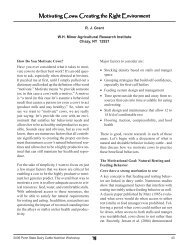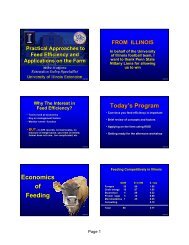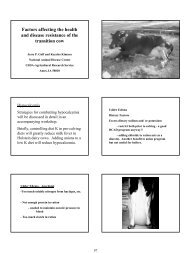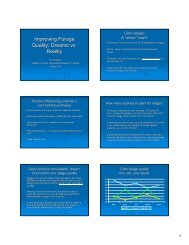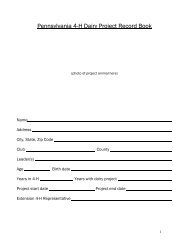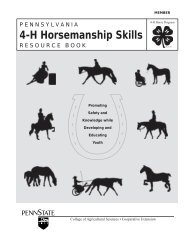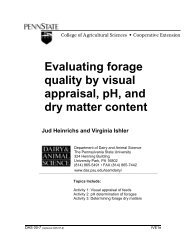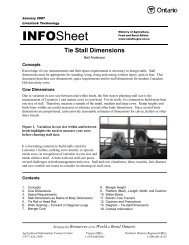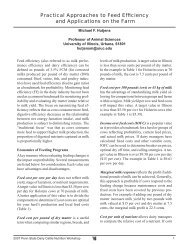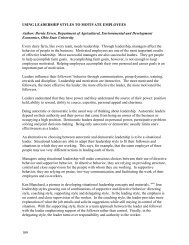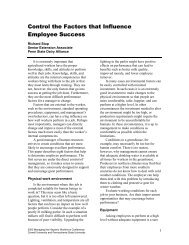DETERMINING THE MINERAL REQUIREMENT OF DAIRY CATTLE
DETERMINING THE MINERAL REQUIREMENT OF DAIRY CATTLE
DETERMINING THE MINERAL REQUIREMENT OF DAIRY CATTLE
You also want an ePaper? Increase the reach of your titles
YUMPU automatically turns print PDFs into web optimized ePapers that Google loves.
poisoning in horses and cattle is associated with lameness and loss of hair and hoof<br />
malformations. Animals at pasture eventually die from starvation due to impaired mobility.<br />
Se can be toxic at 8-10 mg/ kg diet.<br />
Blind Staggers - cattle and horses<br />
Certain plant species such as princesplume, woody aster and (Stanleya, Xylorrhiza,<br />
and Astragalus species) found in pockets of the American upper great plains and deserts<br />
are Se accumulators and can contain several hundred to a thousand mg Se / kg. They are<br />
generally unpalatable but animals consuming these plants can develop Se toxicity. If<br />
consumed in high amounts the animal can exhibit acute poisoning - blind staggers. More<br />
commonly in periods of drought the animals on pasture may be hungry enough to<br />
occasionally eat a few of these Se accumulator plants.<br />
Alkali disease<br />
The soil (usually alkaline soils) may have high enough Se that forage plants grown in<br />
these areas provide more than 10 mg Se / kg pasture may and over time the animals<br />
develop lameness and emaciation- alkali disease. Profitable ranching is nearly impossible<br />
in these particular areas of the country.<br />
Molybdenum<br />
Molybdenum is a component of xanthine oxidase, sulfide oxidase, and aldehyde<br />
oxidase; enzymes found in milk and many tissues. Milk and plasma molybdenum<br />
concentration increase as dietary molybdenum increases.<br />
Deficiency - From a practical standpoint this is not a concern<br />
Toxicity<br />
Dietary molybdenum becomes a practical concern because it antagonizes the<br />
absorption of Cu (and to a lesser extent Phos). Molybdenum toxicosis signs are essentially<br />
those associated with Cu deficiency. Molybdenum and sulfate interact within the digestive<br />
tract to form a thiomolybbdate complex which has a high affinity for Cu. Cu bound to this<br />
molybbdate is unavailable for absorption (see section on Cu). The toxicity of molybdenum<br />
can be overcome by increased Cu supplementation and Cu toxicity can be reduced by<br />
molybdenum supplementation. The critical ratio of dietary Cu: dietary molybdenum needed<br />
to avoid Cu deficiency ranges from 2:1 in reports from Canada to 4:1 on pastures in<br />
England with a high molybdenum content (20-100 mg molybdenum / kg forage DM). In the<br />
United States molybdenum is a significant problem in the western states and around the<br />
Everglades in Florida.<br />
Iodine<br />
Iodine is necessary for the synthesis of the thyroid hormones thyroxine and<br />
triiodothyronine that regulate energy metabolism. Thyroid hormone production is also<br />
increased during colder weather to stimulate an increase in basal metabolic rate as the<br />
animal attempts to remain warm.<br />
Most iodine sources are readily available and the iodides of Na, K and Ca are<br />
commonly used. K iodide tends to be easily oxidized and volatilizes away before the<br />
animal can ingest it. PentaCa orthoperiodate and ethylenediamine dihydroiodine (EDDI)<br />
are more stable and less soluble and commonly used in mineral blocks and salt licks<br />
exposed to the weather.<br />
48




